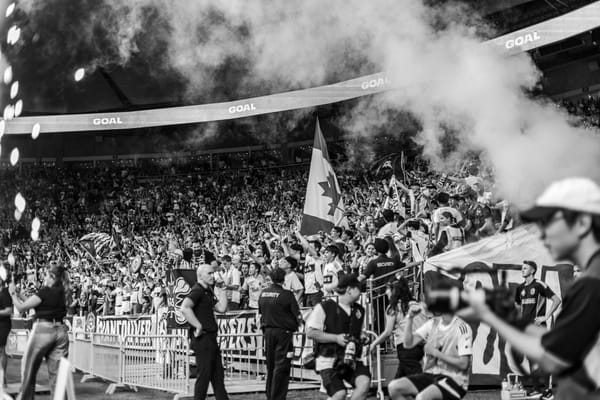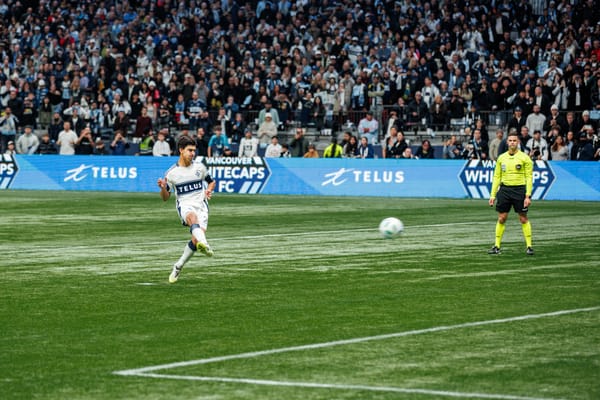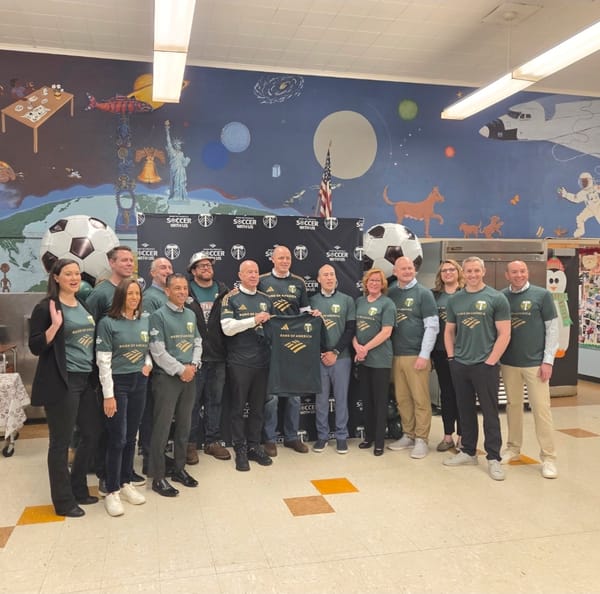An Exercise in Timbering
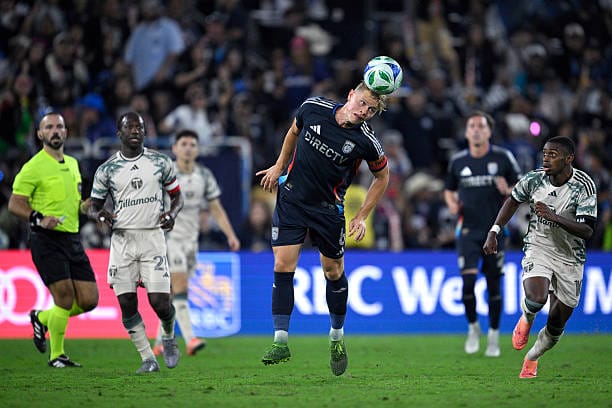
The Portland Timbers lost Game 1 of their First Round playoff series against San Diego. A 2-1 score is more respectable than the 4-0 drubbing received one week ago on Decision Day, but the result remains the same: a loss.
Recap
Last weekend’s 4-0 loss was characterized by the contrast between San Diego’s effortless possession patterns and Portland’s constant miscommunications and turnovers. San Diego’s first chance came from a corner kick. In the 7th minute, a short corner resulted in an Anders Dreyer diagonal ball to the back post. Ian Pilcher attacked the ball with his head and James Pantemis made an excellent save to deny the hosts an opening goal.
This play wasn’t that special, but there’s a simple thing that Dreyer and Pilcher do that make it so effective. Dreyer’s ball is delivered with pace into space. He isn’t looking for Pilcher in particular, but he knows that the makeshift right back will be trying to make a run towards the back post. Pilcher runs onto the cross instead of positioning himself to receive it. He adds more power on the header and makes the chance exponentially more dangerous. The Timbers pass to feet and cross to heads. Their interpretation of space is flawed.
A good spell of possession by Los Plasticos led to Corey Baird receiving a Jeppe Tverskov slip pass in the 9th minute. Baird played a cutback cross with his first touch and Luca Bombino crashed the box and forced Pantemis to make another big save. San Diego took the first 8 shots of the game, and they finally scored on the 8th.
Dreyer's corner kick was cleared and fell right to Manu Duah. The rookie opted for a volley, which took a deflection and hit the post. Onni Valakari was on hand to put the rebound in the back of the net. It's an unfortunate goal to give up, but it was coming. Preventing that goal comes down to preventing the initial corner kick. That corner kick comes from a good spell of possession and David Ayala putting Luca Bombino's cross out of play.
One minute later, the hosts nearly doubled their lead when a Tverskov long ball to Dreyer sent the provisional Newcomer of the Year through on goal. However, Dreyer played a through ball to Amahl Pellegrino, who shot it past Pantemis. The flag was raised for offside on the initial pass from Tverskov to Dreyer. Bullet dodged.
But San Diego was still craving that second goal, and they found it in the 30th minute. Dreyer played a diagonal switch to Bombino, then crashed the box and headed home the resulting cross. MLSSoccer.com's Matt Doyle characterized this play as "Messi-and-Alba-esque." He's correct. It's a carbon copy of a goal that the two Barcelona legends would combine to score from Spain to South Beach. The play functions as a very long "one-two." Good teams and players can pull that kind of magic off. Especially when no one tracks Dreyer's run into the box and allows him to have a free header.
It's also worth noting that the Timbers missed a chance of their own one minute before Dreyer scored. A Jimer Fory long ball was collected by David Da Costa, who found Felipe Mora in the box. His shot was saved by CJ Dos Santos. I wouldn't call this a "big" chance, but I liked the execution of a long ball over San Diego's backline. However, it was their most notable opportunity up to that point.
It looked like a repeat of Decision Day was coming, but then something happened. A timid Timbers team broke out of their shell. Despite the clear lack of ball possession, they managed to find the elements of the game they could control. This wasn't "dominant" by any means, but they were fully back in the game. But the scoreline didn't reflect it. They remained stuck in prayer mode rather than playoff mode.
Then, in the 36th minute, Diego Chara won the ball in San Diego's half. He quickly found Antony, who charged at a retreating San Diego backline. Offering support on the left was Kristoffer Velde. The Brazilian found the Norwegian, and Velde cut the ball back onto his right foot and beat Dos Santos at his near post. Suddenly, it was a 1-goal game again. And the Timbers had momentum.
That was Portland's best chance of the first half. San Diego had a late charge, but the score remained 2-1 at halftime. For the second time in a row, the Timbers began the second half down one goal against San Diego. All they had to do was contain the inevitable onslaught from the hosts when play resumed.
The onslaught came, and Valakari nearly restored the two-goal lead in the 51st minute but blew a golden chance instead. However, in a similar situation to the first half, San Diego's foot suddenly slipped off the gas. The next five minutes would decide this game.
The Turning Point
It began in the 61st minute. Duah decided to get adventurous and carried the ball out past the halfway line. Ayala dispossessed him, and the ball fell to Diego Chara. One perfect pass sent Antony through on goal. In a can't-miss 1v1 opportunity with Dos Santos, he couldn't hit the target. A chipped finish (the correct choice of shot attempt given the situation) sailed wide of the far post. That was aggravating, but the Timbers still had momentum.
They used that momentum to generate another big chance, but this one came from a set piece. Velde sent a low cross to the near post, and Mora won my heart by utilizing a flick-on header to get it to Kamal Miller at the far post. His header went over the bar in the 63rd minute. Two huge chances, and not even a shot on target from either of them.
These events are starting to come quickly. In the 64th minute, Pilcher clattered Velde and the Timbers had another free kick. Due to some horrific camera work, the next part is very unclear. Here's what is known: Fory and Anibal Godoy were engaged in some "handsiness" prior to Velde putting the ball back in play. After Velde struck the dead ball, referee Chris Penso's whistle blew and Fory was shown a yellow card.
Upon further review (multiple different viewings of the live play) it appears that there was an outstretched elbow thrown towards Godoy by Fory. Penso is staring right at it, so he legitimately books Fory. However, this broadcast was terrible, and no replays were shown of the infraction on the television. Very annoying. But annoyance is about to be the least of the concerns for the Portland Timbers.
The broadcast is too busy showing a random replay, so only those in attendance know how this ball gets back to Pilcher. The play picks up with a collision and Pilcher on the ground. Penso runs over, reaches into his front pocket, and quickly brandishes a yellow card. It’s unclear which player has committed this offense. But the camera finds Fory, and his look of disbelief as Penso reaches into his back pocket is utterly depressing. The director cuts to the sideline, where Phil Neville and his assistants are engaged in some kind of discussion. Neville is irate. Fory is resigned to his fate. He slowly rolls down his socks and removes his shin guards. The Colombian slowly walks back to the locker room. Neville is still in a heated conversation with his subordinate coaches. The camera pans back to the main actor: Penso. He’s having a discussion with Velde. Fory heads back to the locker room, Neville is shown one last time, and finally play resumes.
Throughout this entire sequence, only one replay of the actual challenge is shown. Many viewers might have missed it. In such an important game, the two biggest calls combine for only three replays. It’s a complete shock to the viewers at home. But each of these plays come with controversy.
Clips are back, y'all. Thank God.
Fory’s first yellow is definitely dumb. But Godoy invites the contact by trying to rile Fory up first. He is the instigator, and he makes a meal out of the thrown shoulder (it’s not an elbow). Penso isn’t watching the entire play develop; he only sees Godoy go to ground and the intentional swing by Fory. There’s another angle from behind the play that gets shown immediately after.
This replay is also helpful because it shows that Fory’s swing was absolutely intentional. Whether or not he makes contact becomes the key to the play. VAR official Carol Anne Chennard is looking at this, but she does not recommend a review for a red card. I think that this review doesn’t get initiated because there isn’t “clear and obvious” proof that Fory makes contact. Either way, Fory is now on a yellow.
Another angle is shown from down the line, and it’s even more “clear and obvious” that Godoy made a meal out of it. The error from Fory is throwing the arm in the first place. It’s going to get called regardless of whether or not contact is made. Directly after this second replay, the broadcast picks up with Pilcher on the ground.
This is the replay that the viewer is provided with. Fory is taking an angle away from Pilcher and going only for the ball. He’s not running directly at the San Diego fullback; he’s merely trying to challenge for the ball. His foot doesn’t make contact with Pilcher. Only his knee does, which runs into Pilcher’s outstretched boot. Pilcher makes a complete meal out of this. It isn’t a hard challenge in the slightest, and Pilcher is the one who is making the most forceful contact during this play by KICKING FORY.
I do not understand how a player can get sent off for being kicked in a playoff game. Late challenges are often illustrated by intent and a late boot, not a late knee. Fory’s contact is purely incidental, and Penso has no right to immediately brandish a yellow card for this. In real time, it looks rough, but that’s exactly why VAR exists. If it was a bad enough foul for “serious foul play” or “endangering an opponent” to come into play, Chennard would be all over it. But it leaves an especially sour taste when Wednesday’s events are taken into account.
In the Wild Card Game, Noel Caliskan had a similar sequence. First was a dumb off-ball yellow card, and then a reckless (Fory was being reckless, but not to the extent of another booking) and DANGEROUS (Fory’s play does not meet that criteria) sliding challenge with studs exposed into Diego Chara. Guido Gonzales Jr did NOT book Caliskan a second time for this willful disregard for his previous booking. Four days later, Penso finds the one sequence that could uniquely infuriate the majority of the viewing audience. After all, most San Diego fans were in the stadium, were they not? Another monument to the consistent inconsistency of PRO.
It’s also a shocking parallel to Fory’s booking and sending off against Club America back in August. Another dumb off-ball foul (this one was dissent) resulted in an initial yellow, before a risky (but ultimately clean) tackle forced Guido Gonzales Jr (there’s that name again) to show Fory a second yellow. I’ve written at length about the various officiating errors I’ve seen in Timbers games this year. But there are several things about this one in particular that really tick me off.
Tonight’s game was a playoff game! Prior to Fory’s first yellow, Penso had neglected to show any cards and seemed to be willing to let each team utilize their physicality. I didn’t notice any “definite yellow cards” aside from a Godoy dive in the first half and Pilcher’s 64th-minute tackle, but I could see those plays going uncalled in a game like this (not Godoy’s dive, that was heinous). Penso immediately dropped all standards that he employed for this game and changed his own style directly in the middle of play.
The final point I will make about this play is a much-needed change to the rules of VAR. Although I’m still not a fan of assisted replay for several reasons, it’s not going away anytime soon as every single sports league gets optimized to the nth degree. I think it’s an absolute disgrace that straight red cards are reviewable and second yellows are not. Reviewing any yellow card is ridiculous, but second yellows directly affect the outcome of a game. As illustrated above, a yellow card can be issued for a variety of infractions, and most of them are guided by the referee’s own discretion. Allowing second yellows, which reduce a team down to 10 men, to be reviewed is a rule that needs to be introduced in the near future.
I’m still bewildered by this entire sequence. Antony’s miss, to Miller’s miss, to Fory’s double booking. This could be a microcosm of the entire season, even though it’s only Portland’s second straight red card in MLS play during the entirety of 2025. Maybe I’ll talk about that later. After all, there’s still about 30 or so minutes of game time left. Wait, wait, wait. One last thing, I promise.
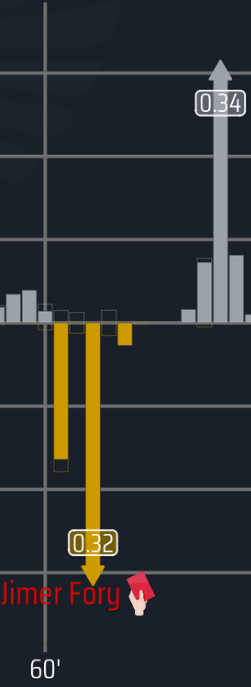
Yikes.
Recap, Continued
That large gray bar represents another missed chance for Valakari in the 71st minute. Portland had two chances that could be represented on this graph, but both were pretty low-value. However, with the right touch/run, they could’ve tied this game. I’ll get into them later. There’s one other abstract thing to touch on before this “recap” portion can end.
In a normal two-legged playoff series, San Diego would be encouraged to keep pushing for more goals to extend their aggregate lead. After Valakari’s missed chance in the 71st, they were much more inclined to keep possession with their opponents down a man. For all intents and purposes, this game essentially ended with Fory’s red card.
Because MLS insists on this stupid Best-of-Three format in the First Round, aggregate score doesn’t matter. This game became a turgid watch after the 66th minute. Could the Timbers find an equalizer? Very unlikely, which made this game a chore to finish. A neutral fan would’ve tuned out entirely. In a proper two-legged series, Portland’s 2-1 result would’ve been massive as they head back to Providence Park with a one-goal deficit and an away goal. However, if aggregate scoring was in play, San Diego probably would’ve added another two goals in the half hour that the Timbers were playing with 10 men. But there was nothing incentivizing them to do so. They had the result in the bag, as long as they kept possession.
Out Of Possession
That’s a perfect segue to today’s main talking point. San Diego entered this game averaging the most possession per game in the league (60.8%). That’s a pretty high number, and the Timbers would be wise to let them have the ball and try to attack directly upon forcing a turnover. They continued with their usual out-of-possession look: a semi-press that can be easily broken and manipulated.
I thought Portland did a decent job in their own half in terms of their shape. San Diego’s off-ball movement and incisive passing were always going to be tough to overcome, and the Timbers were always going to concede a fair amount of chances to a team of their caliber. Watching San Diego’s offense at work made me think more of Portland’s struggling attack than the way the Timbers defended. But when San Diego had possession in their own half, the Timbers failed to accomplish the primary objective of a high press: force turnovers and attack quickly.
Time for a contradiction. The Timbers did this! Velde’s goal was born from this exact plan. However, this strategy did not work to the fullest extent.
I’ve realized the true purpose behind Neville’s 4-2-4 out-of-possession structure. I get why this particular formation has been utilized all year.
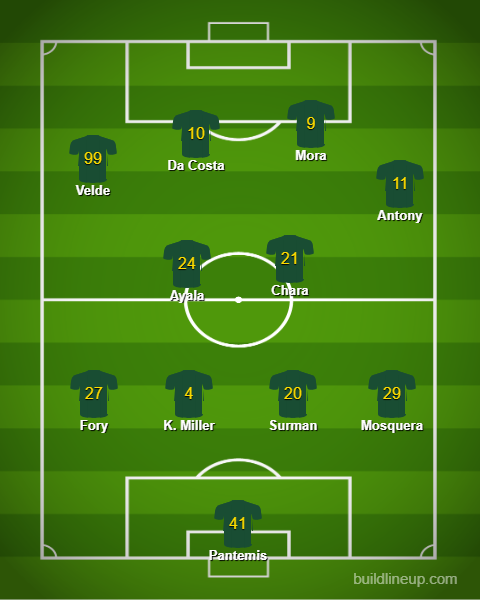
That Velde goal is the exact reason that the coaching staff has persisted with that structure all year. The second line is the key. That ball is supposed to be won by the second line, which quickly progresses it to the first line. Portland’s first line consists of four players, who should have a downhill advantage during this sudden counterattacking opportunity. But two flaws with this structure have been exploited throughout 2025.
The first is the amount of pressure placed on the second line to win the ball back. San Diego has a three-man midfield which puts Portland’s two midfielders at a numerical disadvantage. It took a brilliant Diego Chara play to create the advantage that led to Velde’s goal.
The second flaw relates to Chara’s first action after winning the ball. The Timbers, for whatever reason, don’t immediately take advantage of these situations. Chara is 39 years old, and his decision-making is still streets ahead of every other player on the roster. Yes, it’s another reminder of how good Portland’s legendary captain is, but the true “Chara replacement” will only arrive when another player can provide the mental quality that still makes him one of Portland’s first-choice midfielders. Cristhian Paredes, Joao Ortiz, and Ayala do not have that superhuman ability that Chara possesses to consistently make the correct decision 95% of the time. For example, when Ayala is the one who wins the ball in the second line, his first pass usually goes sideways or backwards.
The Timbers are consistently stuck between identities. That is a point that deserves some expansion, but I’ll save it for when this series ends (regardless of result). Their constant flip-flopping between direct and indirect, intense and passive, and clinical and wasteful. The out-of-possession structure is the perfect on-pitch allegory for their conflicting identities.
They want to press, but the first line is only there to take advantage of the second line winning the ball. They want to go direct, but the second line doesn’t always go forward when they win the ball back. It’s masterful. On paper it’s a decent idea. But once you factor in the improbabilities of the second line continually winning the ball and the ball immediately being progressed to the numerically advantaged first line, it becomes a liability. Especially against teams that are perfectly equipped to play out from the back. Especially against teams that can play a simple line-breaking pass through a first line that isn’t providing the proper pressure that a normal press would contribute. They’re stuck between pressing and playing a mid block. And it constantly leaves them unprepared and scrambling when the first line is bypassed, especially against teams that can turn a simple through ball into a direct attack. San Diego fits all of those criteria. And yet, the 4-2-4 was ever-present tonight. Of course it was.
Player Ratings
James Pantemis: 9
This is a tough grade to give. Based on his primary job (stopping shots) Pantemis deserves a 10. Several spectacular saves kept the Timbers in this game, and his consistent proficiency at shot-stopping has kept him in the starting role.
But one week after multiple giveaways and suicide passes doomed the Timbers against San Diego, Pantemis continued those errors. They didn’t get punished to the extent that they did on Decision Day. By continuing to play out from the back and tempt fate, the Timbers proved that they learned very little from last weekend’s defeat.
Juan Mosquera: 7
I thought that Mosquera’s outing was solid. Some good defense (like an excellent sequence in the 43rd minute) did not come with the attacking presence that he usually brings. However, he was willing to try long balls into space. I liked that a lot.
Finn Surman: 8
Most of San Diego’s attacking activity took place on the right wing, which is the opposite side of Surman. However, Surman was pressed into action continually during the period of time that Alex Mighten was on the pitch. The English winger became the latest player to be added to Surman’s growing pockets. He went to work in “Surman Time,” which I’ve coined to describe the first 15 minutes of the second half. Because the Timbers don’t do a great job of coming out of halftime in a positive stance, Surman has to do a lot of work during that time period.
Kamal Miller: 6.8
Let’s begin with the good. Specifically this pass.
This is a risky ball, but Miller hits it with enough pace to bypass Dreyer. Plus, it leads to a decent Da Costa switch. Nothing comes of it because Antony doesn’t continue his run. More on that later. This section is about Miller.
That missed chance is absolutely brutal, and it should’ve been put on target. He made a couple of good defensive plays after the red card. I thought it was an unspectacular performance, but a solid one. The missed header weighs pretty heavily on this grade.
Jimer Fory: 7
I don’t think a player should get punished for trying to close down a long ball. In doing so, Fory showed more willingness to defend on the front foot than most of Portland’s first line. That’s one way of putting it, but I have to acknowledge the other side of the coin.
This is the viewpoint that most people have taken about this second yellow card. Their belief is that Fory put himself in a position for the referee to make a decision. Ironically, I’ve been asking the Timbers to put themselves in positions for opposing defenders to make a decision. I agree with this perspective, but I also believe that the referee should be held accountable for making bad decisions. This has happened twice to Fory this year. It’s rather annoying.
Prior to the two minutes of terror, Fory was putting in an excellent shift. This included the excellent long ball to set up Mora’s chance in the 29th minute. His box defense was excellent, even though San Diego’s constant movement provided some trouble. It’s a shame that his playoff debut ended in infamy.
Diego Chara: 9
The captain played the full 90 for the second game in a row, and it appears that Neville’s decision to manage his minutes throughout the season paid off in spades. Both of Portland’s big open-play chances came from the Colombian. His through ball to Antony should have resulted in an assist. The only question is whether or not he can go the full 90 in Game 2. Fine wines wish they could age like Diego Chara.
David Ayala: 7.4
Ayala put in the dirty work during this game. He led all players with 4 tackles, but looked more and more tired as the game wore on. It’s worth noting that he’s played the most minutes of his professional career during this season. Replacing him wasn’t an issue, but it could’ve happened a little earlier than the 84th minute. I’m still impressed with his impact and physicality during his first “true” playoff game.
Antony: 6
That assist is really holding up this rating.
The ineffectiveness of Antony has been blatant over the past few weeks. I feel like his last quality outing was on September 27 against Dallas. Prior to that, he was a real difference-maker in the Vancouver draw. In fact, you have to go back to August 29th to find the last time he didn’t play the full 90 in a Timbers game.
I think the heavy workload is weighing on him. Particularly during this week, when there were multiple opportunities to give him some rest. However, physical exhaustion does not apply when poor decision-making comes into play.
For some reason, he receives a lot of passes with his back to goal. That seems to be a function of the system, not the player himself. However, those back-to-goal receptions could work if the Timbers found a way to utilize the pump-and-go. That’s an American football term, but the play works similarly to a common wide receiver route. I’m not sure if it’s the actual term, but y’all probably (hopefully) know what I’m talking about.
If Antony receives the pass with his back to goal and immediately moves it to another player in a deeper position, it gives him the chance to make a run in behind and receive an incoming long ball. This is how Antony’s superpower (his speed) can be properly utilized. Unfortunately, he doesn’t want to make that run. He wants the ball at his feet. There were multiple times in tonight’s game where he had time and space to make a field-stretching run behind San Diego’s defense. When he made that run, it led to the blown chance. Antony has the talent to make those chances readily appear. However, he doesn’t do that run unless the opportunity is blatantly available.
Take that clip of Kamal Miller’s pass I embedded above. There’s ample space in the channel between Bombino and McVey, but Antony moves into the pocket instead. I would be more willing to credit it to exhaustion if I didn’t see that exact type of move over and over again throughout the course of this season. He is better on the left, yes, but any player with that kind of pace should be able to play on the right. He’s done it before as a wingback, for God’s sake!
That Vancouver performance still sticks out in my mind. Mati Rojas played several tantalizing through balls to the Brazilian, and he proved to be a constant thorn in the Whitecaps’ left side. But when Antony isn’t playing to the whistle (two plays in the 53rd and 82nd minutes) it’s time for a change. I’d like to see him as a supersub in Game 2; someone who can break open a game with his devastating pace. It worked against Club America, after all.
David Da Costa: 6.9
It doesn’t shock me that Da Costa exited the game after the Timbers went down to 10 men. After all, they needed all 10 of those players to defend.
Playing in the left channel of the first line of Portland’s pressing structure, Da Costa barely provides any kind of pressure. Velde, on the other hand, is equally active in and out of possession. But Da Costa is Portland’s DP number 10 because of what he can do on the ball. Portuguese Dave wants to spam through balls. He barely has anyone to spam through balls to because no one wants to make the run for him. It’s a strange paradox. However, I really liked his chip to Mora that set up the 29th minute chance. But the Timbers needed him to defend, and he didn’t. I think he suffered from not getting on the ball as much. That’s a pretty good storyline from this season.
Kristoffer Velde: 9
This score was very close to drastically changing in the 6th minute of second-half stoppage time. A fair and just referee would have sent him off for a blatant use of “violent conduct” as a response to a late challenge from Pilcher. Both players were going at each other all night, and both were booked for this infraction. Velde got lucky to escape without serious punishment. Congratulations to Chris Penso, by the way. I don’t think I’ve mentioned that yet.
I’m thrilled that he scored his first goal. It provided the lifeline that the Timbers needed for the second half. This should signify the breaking of the dam. Velde took “being direct” to a whole new level in this game. He completed 7/15 of his passes, but was swarmed whenever he got the ball. A sumptuous outlet ball in the 54th minute sprung Da Costa on the left wing, but nothing came of that chance. The Timbers needed someone to drive them forward in this game, and Velde filled that role with aplomb.
Felipe Mora: 7
This grade is for the flick-on header to Miller alone. I’d like to order ten million of those.
The Chilean had a big chance again, but it was well-defended by San Diego’s retreating backline. It’s unfortunate because of what came directly after (Dreyer’s goal) but I thought Mora had a solid game for a striker with very little service. It’s great to see him playing with confidence again.
Ian Smith: 6.6
The rookie was brought on as Fory’s replacement at left back. He wasn’t tested too much, but held his own. A miscommunication between himself and Velde in the 88th minute was a little rough.
Omir Fernandez: 6.6
Fernandez played centrally after entering in the 72nd minute. He didn’t really impact the game that much. I think this game was calling for Ariel Lassiter instead of the skillful American attacker.
Cristhian Paredes: 6.8
The Paraguayan didn’t come on the pitch until the 84th minute, but he provided a nice flick to Antony in the 5th minute of second-half stoppage time. Nothing came of that flick.
Kevin Kelsy: 6.6
Antony did feed Kelsy in the 90th minute, but the large Venezuelan went to ground in the box after failing to control the ball. Duah provided some physical contact, but Kelsy doesn’t get those calls. That play was set up by Chara winning the ball in the second line. Notable.
Coach Rating: 2
Initially, I was going to give Neville a 4. Then I remembered the subs.
Smith for Fory is a pretty decent change. After all, it’s like-for-like. But I’m confused why Fernandez entered this game so early. At that point, the Timbers were desperate for a field-stretcher. Fernandez offers more in possession than Lassiter, so I saw it as a double down rather than a change in strategy.
Neville was once again outcoached by Mikey Varas, but that’s a common trend around the league. Entering halftime with a 2-1 deficit provided a prime opportunity to adapt to the first half. Per Finn Surman, the message at halftime was, “Come out and play with intensity. We believe we can win this game.”
The game was certainly winnable at halftime. But the Timbers needed more help than just “intensity” to win. Two good chances came, but San Diego had a couple of their own before Portland threatened Los Plasticos’ goal in the second half. The choice to bring on Fernandez instead of Lassiter confirmed that Neville saw Portland’s way of finding an equalizer being through possession rather than on the counterattack.
It took him 12 more minutes after the Smith-Fernandez introductions to make his second change. Paredes and Kelsy replaced Mora and Ayala. Once again, those were two like-for-like substitutions. I don’t have a problem with that. However, Lassiter remained on the bench. By this point, Antony looked completely off the pace. But Neville couldn’t bring himself to sub off the Brazilian. Why?
That’s a question that I’ve answered before. This is a perfect transition to a question Neville has answered before. I screwed up by not writing about the out-of-possession structure in my preview, but I figured y’all have gotten pretty sick of my fixation with Portland’s mostly ineffective setup. It was the main question on my mind entering the post-game press conference. So I asked about it. Before I write down his full quote, here’s what I asked: “Hi, coach. First 30 minutes, obviously the team had a tough time adjusting to San Diego. What was the game plan coming in, specifically out-of-possession?”
I like attending open training sessions to get a feel of what the team is preparing for ahead of each game. These sessions are very insightful, but I didn’t witness a lot of out-of-possession work during Friday’s availability. I think it’s a fair thing to ask about. Here’s how Neville responded:
“Well, I think if you watched the full game, Jeremy, you would have seen that we started a little bit too nervous, a bit cautious. A couple of younger players, it was a big occasion for them and they started with a little bit of fear.”
Quick detour. San Diego’s backline featured a 22-year-old, a 20-year-old, and a 19-year-old. Putting that in my notes.
“Once we went 2-0 down, we then lost all those nerves because we had nothing to lose. And then we dominated the game, in terms of, say, dominated the game. We were really in the game.”
I think he’s using the word “dominance” in the place of “control.” The Timbers certainly gained more control throughout this game, but there was never a period that they fully dominated outside of the 61st-66th minute stretch that ended with Fory’s red card.
“You look at the chances at 2-1 for Antony and Kamal and then Chris Penso took over the game. This game is not about out-of-possession. This game wasn’t about out-of-possession. This game was about Chris Penso, and congratulations to him.”
There it is. My favorite Phil Neville quote of all time. The tone he struck with the “congratulations to him” was sublime. It was perfect. I use that exact phrase extensively with both sincere and ironic connotations. I had to pause my train of thought because I wasn’t 100% positive that I had heard him correctly. But I did. It’s a work of art.
The other part of this is the complete disregard for my initial question until the end of his response. Sometimes Neville answers, sometimes he doesn’t. What he always does is give a response. This was a definite answer, and it’s a pretty disappointing one.
This game was entirely about out-of-possession play. That's what happens when your team is on the road and finishes the first half with 37% of the ball. When you’re in a playoff game against this San Diego team, you’re not expecting to see a fair amount of possession. How Portland defended in this game would provide a platform for their attack. That attack didn’t have much of a platform aside from Diego Chara defensive actions and Kristoffer Velde moments of brilliance. Anyways, congratulations to Chris Penso.
The quote ends with “It was Chris Penso’s night.” Sure. Fine. Whatever. Fory’s second yellow card did completely blunt Portland’s momentum. But they were already down 2-1 at halftime, and the only major error from Penso in the first half was his refusal to give Godoy a yellow card for simulation. I’d throw Pilcher’s potential yellow on Velde in there as well. None of those plays could have directly changed the outcome of the game, but the second yellow card did. In some way, Neville could be thanking Penso for not sending Velde off in the dying moments of this game and forcing the Timbers to play Game 2 without their offensive talisman. Maybe that’s what the congratulations were for.
The Timbers decided to be conservative after the dismissal despite aggregate scoring not mattering. It was time to throw caution into the wind with only upside to be gained from throwing men forward into the attack. Instead, they formed a back five with Smith and Antony as wingbacks. They continued to try and play their (mostly ineffective) possession play instead of showing the aggression that could have forced a penalty shootout. Sure, it could’ve dug them a deeper hole, but a 2-1 deficit with 10 men in a road game against the top seed in the Western Conference is already a pit that Christian Bale’s Batman climbed out of.
Bracket Time
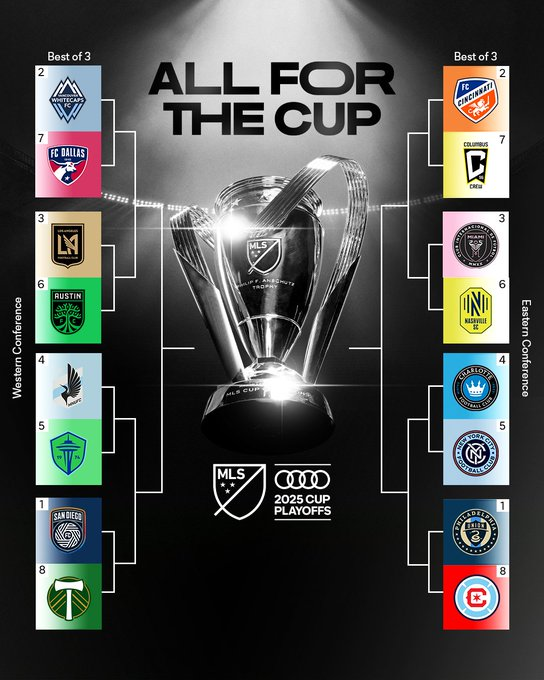
Vancouver thumped FC Dallas by a score of 3-0 (and it wasn’t even that close) to take a 1-0 lead in their series. Philadelphia beat the Chicago Fire in penalties. Chicago was down 2-0 in the 75th minute, but fought back with 2 late goals to force the shootout. Can’t have everything, I guess.
Final Whistle
I’ll keep this brief because I’ve already been babbling for too long. Tonight’s game was a missed opportunity, and now the Timbers need to win two straight games against San Diego to advance to the next round. They’ll have to win at home next Saturday without Jimer Fory. Tall task, but this is the kind of high-stakes pressure-packed game that this team needs to stay on their “competitive growth” trajectory.
The 61st-66th minute sequence is a pretty good explanation of Portland's season in a nutshell. They needed to score one of those two chances because they don't create a lot. Neither chance went into the back of the net. Then a ridiculous tide-turning moment occurred that was born out of an individual error. The individual errors have taken different forms throughout this year. Some are refereeing blunders, late penalties, late goals, or other missed chances. The Timbers get punished repeatedly in quick succession after missing big chances. Pretty wild how that keeps happening. I'd like to call it "Timbering." After all, the Jets own the "shooting themselves in the head" metaphor. It felt wrong to apply it to the Timbers.
San Diego is home to a naval base. In today’s game of soccer, the Timbers kept their trusty canoe in tow as they returned to the water after a brief bull-ride against Real Salt Lake. I previously said that Los Plasticos brought a canoe to Portland last weekend. Forgive me, because sometimes I can’t see what’s directly in front of my face. It wasn’t a canoe, but an entire battleship.
Battleships used to be the anchor of a nation’s naval force until the aircraft carrier changed warfare forever. These ships cannot launch airplanes, but they are the most feared vessels on the open seas. The firepower packed into a battleship is utterly terrifying. But having the firepower can only get you so far. The ship needs to be properly calibrated in order to deal maximum damage.
An entire crew is key to making the battleship work. San Diego has built themselves quite a ship and that ship has quite a crew. When the Timbers showed up in their trusted canoe, the sheer size of San Diego’s vessel overwhelmed them. Do you really need to use all of your firepower to defeat the canoe? No you don’t. So San Diego’s warning shots allowed them to win this duel by simply keeping the canoe at a safe length where nothing could provide any threat. But the canoe got too close because the battleship relaxed with a safe 2-0 advantage. Once the canoe was crippled on the manpower front, the battleship didn’t need to annihilate Portland’s wooden boat. They could simply dance around it and get the result that they needed.
That battleship will be coming to Portland next weekend, and the Timbers will need to find every advantage they can in order to have a chance at another duel in San Diego Bay. Their season is on the line again, and they’ll have to provide some structural improvements in order to survive. Or maybe, just maybe, they’ll exit the water and fight on the land again. A statement game is on the horizon. The voyage continues.

